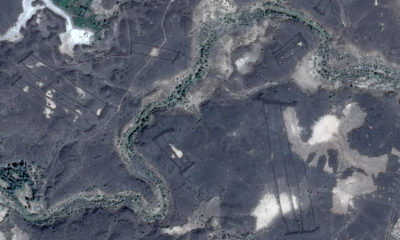In search of meteorite fragments
There’s some good news about the meteorite, which fell to Earth and caused a lot of damage. The Chelyabinsk meteorite is thought to have crashed into Lake Chebarkul in Chelyabinsk, Russia, as there was a hole in the ice consistent with an object piercing the frozen surface of the lake. The meteorite crashing into the lake might be a lucky break, as the pressure of the crash would have been absorbed by the snow, ice and water. If it had hit land, it would have either created a relatively big crater or caused a forest fire.
But that’s just the first good news. This time, there’s a rush to find precious meteorite fragments from the space rock which can be worth astronomical sums of money.
Authorities estimated the property damage to be around $33 million around the city. The meteorite also caused injury to 1,200 people from shattered windows as a result of the blast. In the aftermath of the meteorite crash, people from all over are slogging around in the snow and ice to find fragments of the meteorite. The “meteorite rush” has led to some speculation. A member of the Russian Society of Amateur Meteorite Lovers estimates that the meteorite fragments could sell as high as 66,000 rubles ($2,192) per gram. However, the fewer fragments found, the higher the price would go. There might be some fake meteorites for sale soon with the increased demand for meteorite fragments.
Precious meteorite fragments are in demand
So far, scientists have found 53 small stony black pieces which have been confirmed to be from the meteorite. These were found around Lake Chebarkul, located near Chelyabinsk. These small stones were from 5mm to 10mm in diameter. The scientists also point out that there might be larger pieces under the lake where the bulk of the meteorite volume seem to have landed. Russian scientists have studied the fragments and found them to contain 10% iron, among other elements.
NASA had earlier estimated the meteorite to have been 17 meters across and weighing 10,000 tons prior to entering the atmosphere. The heat of entry would have burned off a big part of it and splintering it into pieces. The bulk of the meteorite was traveling at around 30km per second, or around 1,100 mph, which is approximately twice the speed of sound.
Meteorite fever
A lot of dashboard cameras captured the fireball just before it crashed to earth. The path of the meteorite brought it over a major highway. It is not a coincidence that most Russians have dashboard cameras in their cars for insurance purposes. The icy road conditions cause a lot of major accidents and footage from the dashcams are used as evidence when filing claims. This time, the dashcams captured the meteorite just before it crashed to earth.
Meteors are composed of rocks and other space objects which fall to earth and burn up in the atmosphere. On the other hand, if a meteor is large enough and a portion of it crashes to earth, it is called a meteorite.
Throughout the centuries, people have looked forward to watching meteors. Perseid meteor shower is an annual event with plenty of people watching the skies during mid-August for the meteor display. The Geminid meteor shower occurs in mid-December to early January. Both meteor showers are thought to be debris from a shattered asteroid or comet.
In this case, meteorite fragments are sought by scientists so they can study it and learn more about space. Collectors on the other hand are willing to buy pieces of space rock for their collection and bragging rights.















Facebook
Twitter
Pinterest
Google+
LinkedIn
Email